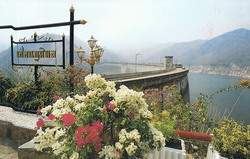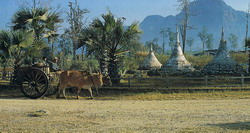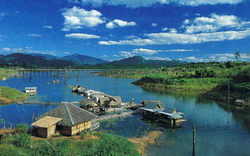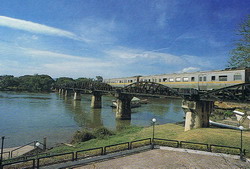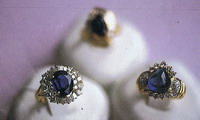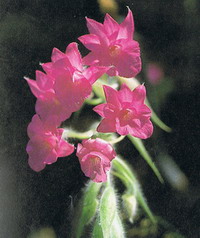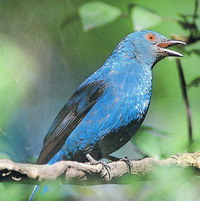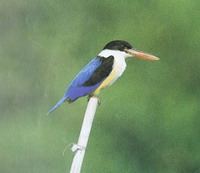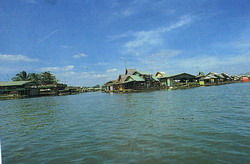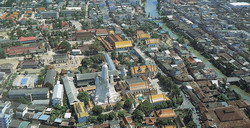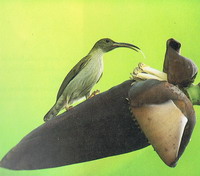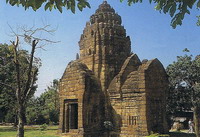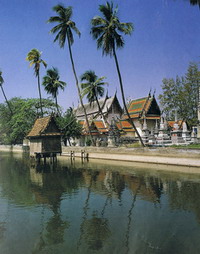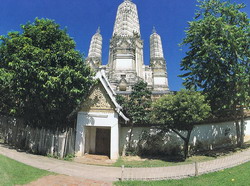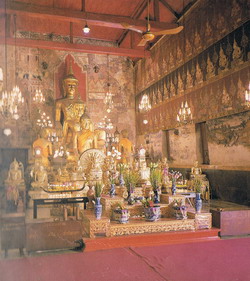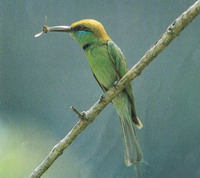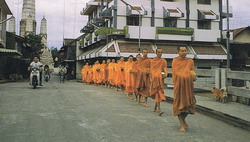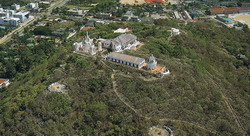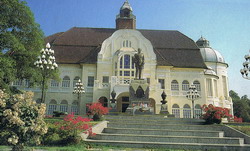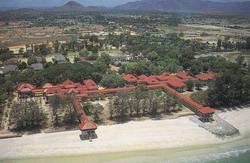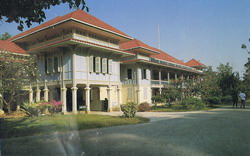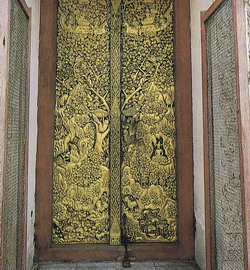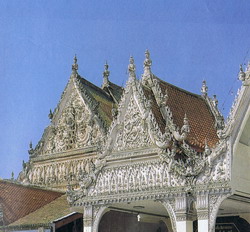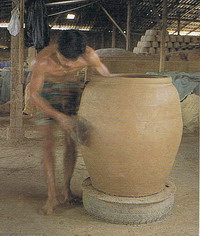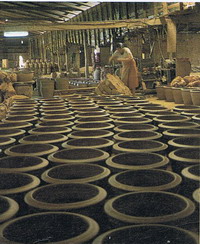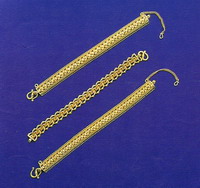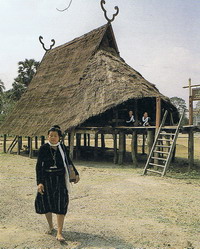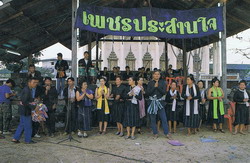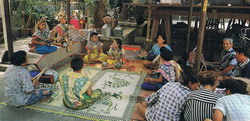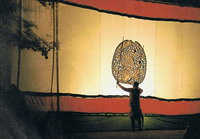
Search
 Custom Search
Custom Search
Cultural Landscape of the Westerrn Region of Thailand Geography
The western region of Thailand, which lies between latitudes 11 - 17 degrees north and longitudes 98 - 100 degrees east, is an area in which the provinces of Tak, Kanchanaburi, Ratchaburi, Phetchaburi and Prachuap Khiri Khan are located. It covers and area of 53,679 square kilometers, or about 10.46 or the total area of the country (513,115 square kilometers). The physical features of the western region of Thailand are similar to those in the north as it consists mostly of mountain and valleys. However, it is different from the northern region in that some areas are close to the sea. The western region can be divided into three parts, each with its own distinctive physical features, namely the mountain ranges, the alluvial plains, and the coastal plains.
The Mountain Ranges To the west of the western region are long chains of mountains which stretch from north to south in an unbroken line. Essentially, there are two montain ranges, the Central Thanon Thongchai Ranges and the Tenassarim Range. The Central Thanon Thongchai, a fairly long mountain range, starts in the north, passes through Tak province, eventually ending up to the east of the Khwae Noi River in Kanchanaburi. The total length of this mountain range, from the northern to the western region, is 880 kilometers. The Tenassarim Range starts out to the north of the Three Pagodas pass, in the destrict of Sangkhlaburi in Kanchanaburi province, and stretches south, through Ratchaburi, Phetchaburi, and Prachuap Khiri Khan, before coming to rest in the district of Kraburi in Ranong Province.
The Alluvial Plains There are not many alluvial plains in the western region. However, the alluvial plains in this area, including the Ping alluvial plain in Tak district, the Mae Klong alluvial plain in Kanchanaburi, and the Phetchaburi alluvial plain in Phetchaburi, are of a fair size. The Mae Klong River, a major river of the western region was formed when two rivers, the Khwae Noi and the Khwae Yai merged. The Khae Yai River has its origin in Um Phang district in Tak province, while the source of the Khwae Noi River is in Sangkhlaburi in Canchanaburi. From Kanchanaburi, the Mae Klong River flows through Ratchaburi to end up in the Gulf of Thailand at Samut Songkhram. The Mae Klong alluvial plain is the biggest alluvial plain of the western region, and also a fertile agricultural area.
The Coastal Plains The coastline of the Western region, starting from Baan Laem district, in Phetchaburi and stretching to Baang Saphan Noi district in Prachuap Khiri Khan, is 315 kilometers in length. Of the total length, 90 kilometers are in Phetchaburi, and 225 kilometers in Prachuap Khiri Khan. The Phetchaburi coastal plain is quite large as it includes the Phetchaburi alluvial plain as well. In the western region, there are several passes through which people cross the Tenassarim Range for example, Mae Sod Pass, Mae Lamao Pass, The Three Pagodas Pass, Bong Tee Pass and Singkhorn Pass. In addition, there are coastal seaboards on both sides of the region, namely the seaboard of the Andanman Sea and the seaboard of the Gulf of Thailand. As a result, people settled in this area a long time age, and their settlements have since grown into towns and whole provinces.
Physical features and their influence on the occupations of people in the western region The western region is the main source of many rivers. Because of its mountainous landscape, it has provided good locations for the construction of hydro-power plants. Several large dams were constructed to provide water to generate electricity, Bhumibol Dam was constructed across the Ping River at Tak province, Sri Nakharin Dam across the Kwae Yai River, Khao Laem Dam across the Khwae Noi River at Kanchanaburi, and Kaeng Krachaan Dam across the Phetchaburi River. All these four dams supply water for hydro-power stations which have the greatest generating capacity in the country.
Furthermore, there are chains of dams which supply water for irrigation. For example, Vajiralongkorn Dam provides water for the Mae Klong river plain, Phet Dam supplies water for Phetchaburi and Hua Hin district in Prachuap Khiri Khan, Pranburi Dam for agriclutural purposes and consumption in Pranburi and Hua Hin districts, and Yang Choom Dam for agriculture and consumption in Muang district, Prachuap Khiri Khan. All these dams have contributed to the fertility of land in this region and the well-being of the people in the country. Not only have they provided an abundant supply of electricity and water for irrigation; they have also become important sources for freshwater fishery. In the reservoirs above the dams fish and other aquatic creatures provide many people with the means of earning a livelihood and help solve the problem of protein dericiency in this area.
As a result of the skillful management of water in the irrigation system, vast areas of land have been developed for agricultural purposes, thereby boosting the amount of produce and other food supplies available for domestic consumption. The surplus is exported, creating wealth and ensuring the stability of the national economy. There is also livestock farming in this region including the breeding of beef cattle, dairy cattle, pigs, ducks, chickens etc., as well as the aquaculture. Consequently, chains of industries have been created, for example, the sugar industry, the canned pineapple industry, as well as various other industries involved in the processing of agricultural products. All these industries have created jobs and improved the well-being of the people in the region.
Although this has been the target of widespread development and extensive use has been made of land other resources, it si the site of several important national parks and wildlife sanctuaries. Located in this region are Kang Krachan National Park (the largest national park in the country). Sri Nakharin National Park, Saiyoke National Park, Erawan National Park, and Sam Roi Yot National Park. There are also a number of wildlife sanctuaries in this region, icluding the Thung Yai Naresuan Sanctuary, the Salak Pra Sanctuary, and the River Phachee Sanctuary, all of which remain in pristine condition. There are many kinds of wildlife living in the forests, including elephants, bisons, deer, and many different kinds of birds.
By the time primitive society had developed into an agricultural society, the plains of the western region were already ripe for agriculture. Moreover, the region was also a major source of salt. Salt was an important commodity during the formative stages of human society, when there was a quest for wealth with which to build villages and towns and eventually to form a city state. This was because salt was necessary for everyday cooking purposes together with rice, which formed the staple diet of the people, and helped build up one's physical strength. (Even wild animals have to find a salt lick which can help keep them healthy and protect them against certain diseases.) There is, in fact, and old saying which indicates the wealth and prosperity of a society, "a surplus of rice and one's fill of salt", is clear evidence of the importance of salt. Therefore, the wealth and prosperity of a city state in ancient times depended a great deal on the ability to exert control over the source of salt production and the export of salt as a commodity. (According to documents chronicling the history of Nakhon Si Thammarat, at the time whdn it was governed from Phetchaburi, deeds of ownership laying claim to sites where salt was produced were handed down from generation to gerneration.)
Later, when it was discovered that salt (called rock salt) could also be obtained from sources in other regious, salt production in this region became less important. However, people in this area were able to produce another commodity that was in great demand, namely sugar. From that time onwards until the Rattanakosin period, sugar became the region's most important commodity, one brought the city state vast wealth and great prosperity.
With regard to the management of mineral resources, prospecting and mining for minerals has been extensive, among them, zinc, and feldspar and large factories have been set up in Tak province to smelt and produce both. Also, a cement factory has been built in Phetchaburi, a gem cutting factory in Kanchanaburi, and a steel sheeting factory in Prachuap Khiri Khan. In addition, a thermal power station using natural gas from the Gulf of Martaban, is currently being constructed in Kanchanaburi.
The western region boasts approximately 300 kilometers of coastline, composed of muddy beaches or muddy and sandy beaches, expecially Cha-Am beach, Hua Hin Beach, Prachuap Khiri Khan Bay Beach and manao Bay Beach. The muddy beach areas were once lush mangrove forests which have now been turned into sites for shrimp and cockle farms. For example, one inlet in Bang Taboon, to the north of the mouth of the Phetchaburi River, has become a mafor site for aquaculture. Furthermore, the beautiful sandy beaches of this region, with their clean fresh air, have undergone extensive development as tourist resorts, expecially Cha-Am Beach in Phetchabuir and Hua Hin Beach in Prachuap Khiri Khan. These resorts are fully-equipped with all the standard facilities, and are extremely popular among visitors - Thais and foreigners alike.
The community During archaeological excavations, stone tools have discovered, scattered throughout the region. This indicates that the area has been inhabited by Man ever since the Stone Age. In addition, the discovery of several skeletons of pre-historic people together with baked-clay utensils, beads and bronze tools, has provided solid evidence of continuous development in this region. Althoug Buddhism is widespread - and indeed deeply rooted in this region - it does not have a monopoly on people's religious aspiration or hinder people from practising other faiths or religions. As a result, there adherents of different faiths and religions scattered throughou every province; for example, Muslim communities, Christian communities, as well as Chinese communities, which, in turn, boast many different religious sects, as can be seen from their shrines wihch appear in nearly every place that the Chinese have settled.
Since there are many ports and cities in this region, through which travellers pass, there are people of different races, speaking many different languages and subscribing to different religions. As a result, the inhabitants of this region are of mixed race and culture, with their eareer goals and way of life closely linked to the natural resources at hand and skills they posses. Due to the region's location near the border and its mountainous terrain, there are several minority hilltribes scattered throughout the area, for example, the Karen, Karang, Hmong, Muser, and Yao. Furthermore, during several wars in the past, a large number of people were brought into this region as prisoners of war. As a result, a number of people of different races are currently living in this region; for example, there are scattered communities of Mons living in Kanchanaburi, Ratchaburi and Phetchaburi, as well as Thai Dam and Lao Song in Phetchaburi, Ratchaburi, and Kanchanaburi. According to the latest census, (December 31, 1996), the population of the western region is 2,894,991, accounting for approximately 4.9 percent of the total population of the entire country.
The houses is this stringently preserve the characteristics of the national aesthetic. Probably, the word "Thai style" first appeared as a means of describing certain house belonging to the local people, once it become popular to build "foreign-stype" houses. If we take a close look at houses in this region, ti will become apparent that Thai-style architecture has been widely preserved and at present most "Thai-style" houses can be found here.
|
Click Here!
|
The Thai-style house is a fully-developed style of architecture complete in itself, revealing great wisdom in terms of design and choice of building materials. The high, steep roof is capable of draining rainwater rapidly, while the walls, consesting both of solid wooden parts and windows, are suited to the local climate, which changes with the season throughout the year. Raised up off the ground, the structure provides ample space under the house which can serve as a multi-purpose area, and provides safety from floods, etc. The building materials can be obtained from natural materials, which are found in abundance in the surrounding area. These building materials are easy to make, reasonably durable, and can easily be dismantle and moved to another location.
Culture There is evidence of human settlements in this region since pre-historic times, and of their continuous development. It is also noteworthy that ancient monuments and artifacts found in this gegion apparently show signs of foreign influence. This indicates that its past inhabitants haboured a liking for foreign countries and tended to embrace innovation, a tendency that has previaled down to the present day. Furthermore, in the past, the coastline along the western region was a place through which mierchandise from China, Indian, the middle East and Europe passed on its way to the capital city, from whence it was exported to other city states or abroad. Therefore, cities in this region were placed where travellers would stop over for a while and where representatives of various religions spread their teacings. Evidence for this appears in several important ancient monuments and artifacts found in this region, for example, in Prasart Kampanglang in Phetchaburi, Prasart Muang Singh and Prasart Muang Krute in Kanchanaburi, and Phra Prang Wat Mahathat in Phetchaburi. All these ancient monuments were built in the style of the Lop Buri Period.
Contempor to these ancient monuments was Phra Buddha Suwannakhet or Phra Srisanphet Sattapunpan, the largest ancient in Southeast Asia during that period. This bronze Buddha image, five meters in width at the base, is known to people nowadays as Luang Phor To, and is currently situated in the temple of Wat Bovornnivet Viharn. This Buddha image was once the principal Buddha image in Wat Sattapan in Muang District in Phetchaburi, which is now deserted. It was moved to Wat Bovorn in 1927 and the royal craftsmen altered the top knot so as to give it an appearance which, according to the aesthetic values expounded by the Rattanakosin style of arts, was considered beautiful.
The ability to erect such ancient monuments and cast a large Buddha image was an indication of power, economic prosperity, technological progress and skilled workmanship, which constitute the basis of civilization within human society. During the Ayutthaya Period, the cities in this region lay along the border, so they became places in which to mobilize an army, in addition to becoming a battlefield, as well as an important economic zone. It was also a center for education and craftsmanship. Evidence of this can be seen in various religious monuments, famous houses and buildings, among them a building for monks to study Buddhist scriptures, Sala Karn Parien, at Wat Yai Suwannaram, which is the only remaining wooden building dating back to the Ayutthaya Period; and a brick building used as living quarters for monks at Wat Bandai-it, which is the sole brick building from the Ayutthaya Period still in use today. Besides, there are numerous paintings and examples of bas-relief, rendered in the Ayutthaya style, in Phetchaburi. All of this is evidence of the importance and prosperity of the western region.
During the Rattanakosin Period, King Rama IV had a palace built in the European style on top of a mountain in the heart of Phetchaburi, a place currently known as Khao Wang or Phranakhorn Khiri. Whenever he was away from Bangkok,, His Majesty would stay there to perform his duties and to receive visitors. King Rama IV wanted to see more houses and cities built in the European style. This reign witnessed the construction of the very first bridge made from reinforced concrete in this country, — the so-called Chomklao Bridge or Saphan Chang. During his reign, King Rama IV also helped renovate several temples. King Rama V was fond of visiting the western region. For example, His Majesty would write poems and Nirat (long poems describing a journey) when he visited Kanchanaburi and it was there that H.R>H Prince Narisaranuvativongse composed the well-known song "Khamer Sai Yoke". When the southern railway line was built, and Phetchaburi could be reached by rail, King Rama V would pay a visit to Phetchaburi both by boat and by train. His Majesty also had a special interest in arts and crafts.
Towards the end of his reign, H.M. had the Baan Pune Palace built in the European style, so that he could spend his twilight years there. Unfortunately, however, H.M. passed away before the palace was completed. King Rama VI continued the construction of the Baan Pune Palace and upon its completion, named it, "Phra Ram Ratchanivet Palace". H.M. also built a royal camp as a place for relaxation at Bang Talu, on the coast, where he named it Haat Chao Samran. However, due to a lack of fresh water and an abundance of flies, he decided to move and build a new palace at Huoi Sai Nue District, called Phra Rajanivet Marukhathayawan. He often came and spent several days there.
During the reign of King Rama VII, the summer palace, Klai Kangwone, was built for the king to stay whenever H.M. spent the summer in Hua Hin, the most renowned resort in the country at that time. It is the only palace that has remained in use as a royal summer residence down to the present day. It can be said that the western region has proved a favorite spot for virtually every reigning monarch to visit. This is why there are more palaces here than in any other region of the country. Another distinctive feature of this region is that it is a major center of Thai folk culture, which reflects the characteristics of an agricultural society. There are many forms of entertainment that are characteristic of the region for example, Wua Lan (or a bull race), Ten Kam Ram Kiew (a kind of farmers' folk dance), songs celebrating the rice harvest, and group folk singing sessions where the men and women would square off and exchange friendly banter in song - the words themselves being improvised on the spot, not to mention music, an exemplified by Thai orchestral bands and the long-drum musical bands. It is noteworthy that almost all well-known popular folk singers are ntives of this region of nearby areas. With regard to craftsmanship, the goldsmiths, painters, sculptors, and wood carvers of this region all have their own unique styles which have been handed down from generation to generation and continuously developed. For example, the bas-relief work of Phetchaburi, the baked-clay carthenware of Ratchaburi, the cut gems of Kanchanaburi are known for their unique styles and workmanship.
As several Royal Palaces are cited in this region, The Royal Family became familiar with the way of life of the people and were well informed of their problems. For examples, His Majesty the King has launched many projects as a result of his visits to rural areas, and many experiments have taken place in this region. The first rural development project initiated by His Majesty the King was launched when he gave bulldozers to a border patrol police of Khai Naresuan in 1952 to build a road to Baan Huoi Mongkon, Hin Lhik Fai, a subdistrict of Hua Hin, to make it easier for villagers to get their produce to markers outside their communities. The first irrigation project initiated by His Majesty the King involved the construction of the Khao Tao Reservoir in Hua Hin to ease the shortage of fresh water in the dry season, (1957). The area designated as the site of the reservoir used to be flooded by sea water. His Majesty the King thought that a water gate should be built to block out the sea water and that fresh water and that fresh water should be channelled into this area to wash out the salinity. After filling in the area and draining out the water from this reservoir many times, finally people would have a fresh water reservoir. At present the Khao Tao Reservoir works perfectly - just as His Majesty had originally foreseen.
At present, due to the rapid development of virually every region of the country, and the vast increase in population, huge tracts of forest have been cut down and turned into farmland to replace to replace areas which were once used for farming but have now been turned into industrial and residential areas. Especially in the western region, large investments have been made in the development of golf course, accompanied by further environmental and ecological impacts. Poor management of water and land has led to a waste of these natural resources, as well as to an increase in air, and water pollution. Even though members of both the public and private sectors have joined hands in trying to solve these problems, it seems that they cannot make pu for the loss. Because of this, His Majesty the King has initiated several projects in every region of the country to help solve the problems the people are facing, and to alleviate the damage done to the balance of nature.
Among the many projects being carried out in the western region, the Huoi Onkor Development Project at Bhor Phloy District, Kanchanaburi, is the type of project that offers long-lasting benefit both to the people and to the environment, and stands as proof that it is in fact possible for man and the forest to co-exist in harmoy. Another such project is at Huoi Sai, Phetchaburi. The area around the Phra Rajanivet Marukhathayawan Palace in Phetchaburi used to be lush forest inhabited by various kinds of wildlife. Later, when people needed more land in order to earn a living, the forest was encroached upon to the point where eventually it was totally destroyed, and the top soil was rapidly eroded. Tlo solve this problem, His Majesty the King establshed a Center for the Study and Development of huoi Sai, Located in the Phra Rajanivet Marukhathayawan Palace area, in Huoi Sai and Cha-Am subdistricts, Cha-Am, Phetchaburi. Essentially, this project concentrates on the restoration of deteriorated forest areas and the prevention of forest fires by creating fire beaks, for example, ditches and canals or belts of green cash crops. It also tries to involve the local farmers in the restoration and conservation of nearby forests, while simultaneously earning income and profit from them. The General Headquarters of the Border Patrol Police attached to the Police Department, has asumed a major role in coordinating the work of other organizations in this area.
The Project to Develop and Conserve the Environment was also initiated by His Majesty the King. In this project, the Office of the Royal Develpment Project board Office of the prime Minister and the Department of Irrigation have collaborated to find ways and means to solve the environmental problems of waste and polluted water, and to conserve the mangrove forests. The project itself is located in the subdistrict of Laem Phak Bia in Baan Laem district, Phetchaburi, where research and development work has been conducted to find proper ways to treat waste water and dispose of garbage so that there is less pollution to threaten the environment and the mangrove forests in this area can thrive and expand. The projects mentioned above are only some of the projects initiated by His Majesty in the western region of Thailand, the ultimate goal being to enhance the well-being of the people, who after all are the country's most valuable resource.
|
